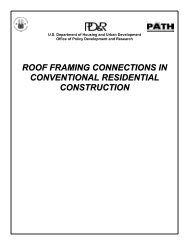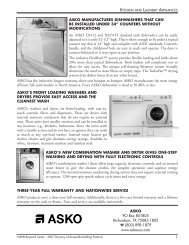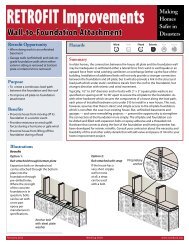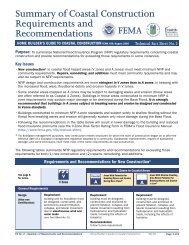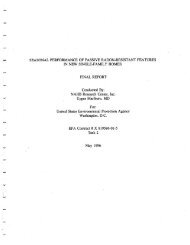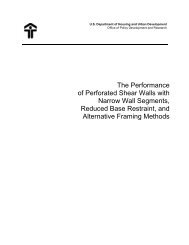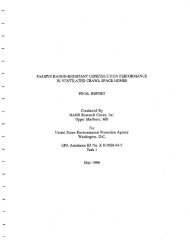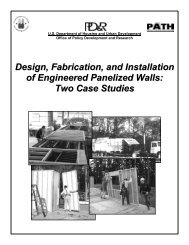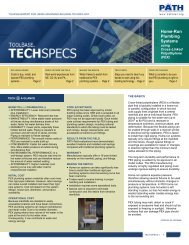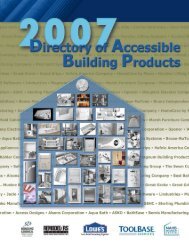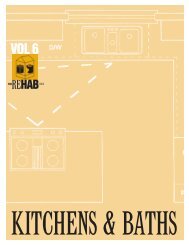Residential Construction Waste Management Demonstration and ...
Residential Construction Waste Management Demonstration and ...
Residential Construction Waste Management Demonstration and ...
Create successful ePaper yourself
Turn your PDF publications into a flip-book with our unique Google optimized e-Paper software.
include a supply-install concept (i.e., creating a direct link between the material<br />
purchaser <strong>and</strong> the installer) could result in the generation of less waste.<br />
In general, builders were reluctant to consider waste reduction opportunities that involved<br />
significant changes in construction methods or even minor modifications to a home's<br />
appearance. <strong>Waste</strong> management was perceived as more of an "after-the-fact"<br />
phenomenon in home construction <strong>and</strong> as less of an integral part of the home<br />
construction process.<br />
Recycling <strong>and</strong> Reuse Sessions<br />
In Gr<strong>and</strong> Rapids, the discussion on reuse <strong>and</strong> recycling was driven by the fact that participants<br />
maintain a high level of interest in alternatives to disposal despite today's relatively low <strong>and</strong><br />
stable disposal costs. In Portl<strong>and</strong>, local government's substantial commitment to construction<br />
waste management has led efforts to educate <strong>and</strong> inform the fragmented building industry about<br />
available recovery opportunities. In Maryl<strong>and</strong>, where virtually no alternatives to disposal are<br />
available, participants expressed general concern that failures to adopt alternatives would lead to<br />
inevitable increases in the cost of dealing with construction waste.<br />
The workshop sessions included both a material-specific discussion <strong>and</strong> a general discussion on<br />
recovery methods. Some key points included the following:<br />
Wood. With significant processing costs <strong>and</strong> the absence of market structures, recycled<br />
wood cannot compete with sources of virgin wood fiber in the production of building<br />
materials. Nonetheless, some counties currently accept source-separated wood waste at<br />
a reduced tipping fee. A facility in Prince George's County, Maryl<strong>and</strong>, for example,<br />
accepts pallets, brush, <strong>and</strong> "untreated" wood for eventual sale to mulching operations.<br />
Given the controversy, however, as to the acceptability of engineered wood products for<br />
mulch because of adhesive content, the possibility of topsoil-applied new-construction<br />
wood waste is uncertain. Not surprisingly, much of the discussion during the Prince<br />
George's County workshop focused on research needs <strong>and</strong> opportunities regarding the<br />
suitability of wood products containing adhesives for various agricultural uses in terms<br />
of environmental, health <strong>and</strong> safety st<strong>and</strong>point considerations.<br />
Drywall. Recycling of drywall into new wallboard is feasible only in areas of the<br />
country close to wallboard manufacturing plants that have or can easily add the<br />
technology required to h<strong>and</strong>le waste wallboard processing. One manufacturer, for<br />
example, has 140 building product distribution centers nationwide that could become<br />
involved in the recovery of waste gypsum wallboard if cost-effective methods of<br />
h<strong>and</strong>ling the materials were developed. In addition, some research on agricultural <strong>and</strong>/or<br />
topsoil application of ground gypsum has been performed, but no studies to date have<br />
addressed any potential hazards associated with trace organic compounds such as dioxin<br />
or heavy metals that may be embodied in waste gypsum wallboard. The Gypsum<br />
Association, in conjunction with the USDA Agricultural Research Service, is just<br />
embarking on a research effort to address this issue. Depending on the results of the<br />
investigation, certain agricultural <strong>and</strong> topsoil uses of waste gypsum wallboard may gain<br />
formal acceptance as an alternative to disposal.



